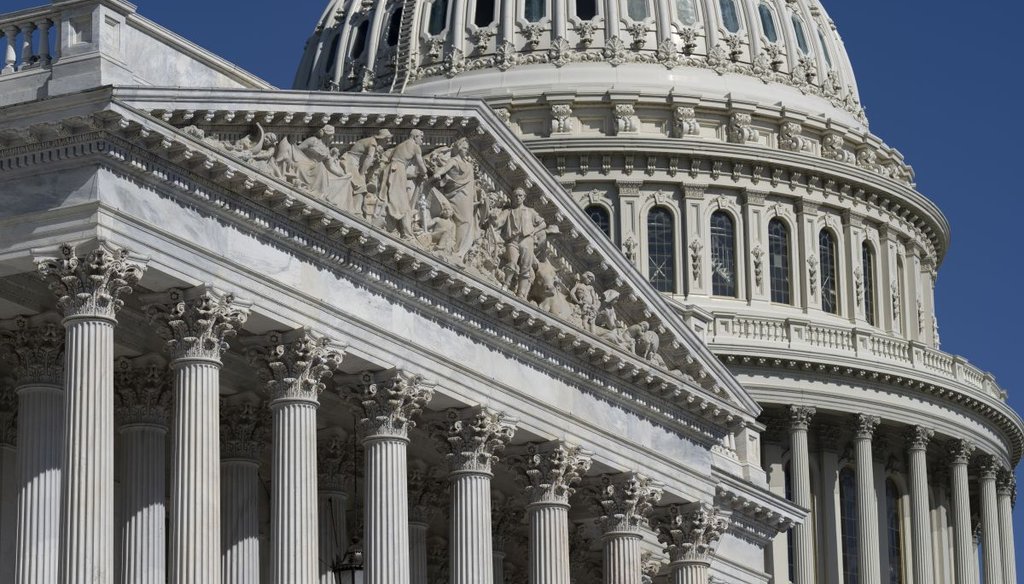Stand up for the facts!
Our only agenda is to publish the truth so you can be an informed participant in democracy.
We need your help.
I would like to contribute

(AP)
Joe Biden’s misleading claim about cutting the deficit
If Your Time is short
-
The annual federal deficit declined by $1.4 trillion on Biden’s watch, from 2021 to 2022. That was larger than any previous one-year reduction in the deficit. Looking at the two-year period from 2021 to 2023, the deficit declined by less, but still by almost $1.1 trillion.
-
The decline happened mostly because the pandemic was an extraordinary historical occurrence that prompted an aggressive, and temporary, government response.
-
On Biden’s watch, even the reduced deficit is larger than any of the deficits on Trump’s watch. And the federal debt has kept rising, just more slowly than it did during the pandemic.
-
How does PolitiFact decide its ratings? Learn more here.
As he has done on several occasions, President Joe Biden used the State of the Union address to tout his administration’s efforts to cut the federal deficit.
During his March 7 address to Congress, Biden said, "I’ve been delivering real results in fiscally responsible ways. We’ve already cut the federal deficit by over $1 trillion."
Biden has presided over smaller deficits than former President Donald Trump’s administration saw in its final year. However, Biden’s remarks omit important context about the unusual federal spending that both presidents approved to stabilize the country during the coronavirus pandemic.
"President Biden has presided over declining deficits, but that’s because the deficit started staggeringly high because of the pandemic," Steve Ellis, president of Taxpayers for Common Sense, a group that tracks federal spending, told PolitiFact this month. "If you compare the deficit to pre-pandemic levels, they are incredibly high. Some of that is still residual effects from the pandemic response and higher interest rates, but it is also from increased spending and decreased revenues."
The deficit isn’t the same as the debt, although the terms are related.
Sign up for PolitiFact texts
The federal deficit is calculated by subtracting federal spending from federal revenue, primarily tax collections, for a given year. If revenue exceeds spending, there’s a surplus for that year; if spending exceeds revenue, there’s a deficit. (There hasn’t been a federal surplus since 2001.)
The national debt is the accumulation of all past deficits, minus any surpluses.
A smaller deficit does not mean the federal debt has shrunk; only a surplus can do that. A smaller deficit means only that the debt grows more slowly than it did before.
So, the debt has continued to rise under Biden. When Biden entered office, the broadest measure of the federal debt stood a little below $27.8 trillion. Currently, it’s around $34.4 trillion, an increase of almost one-fourth in a little more than three years.
The debt also rose under Trump, by about $7.8 trillion over his four years in office.
Biden’s claim about the annual deficit, meanwhile, leaves out important context.
During Trump’s presidency, the deficit rose from $666 billion in 2017, his first year in office, to $984 billion in 2019, his third year.
But the coronavirus pandemic sent the annual deficit into record territory. In 2020, Trump’s fourth year, the deficit skyrocketed to $3.13 trillion, largely because of government stimulus payments, unemployment insurance expansions, business operation grants and increased funding for public health.
The deficit remained high in 2021, another significant pandemic year. That year, a newly elected Biden signed the American Rescue Plan Act, which provided more money for the pandemic response. In 2021, the deficit fell but remained historically high, at $2.78 trillion.
The deficit declines were greater during Biden’s second and third years in office, as vaccines and therapies cut the risks associated with COVID-19 and the economy opened. The deficit was about $1.38 trillion in 2022 and $1.7 trillion in 2023.
The $1.4 trillion decline in the deficit from 2021 to 2022 was larger than any previous one-year reduction in the deficit. The decline from 2021 to 2023 was almost $1.1 trillion.
Although Biden often touts the federal spending from bills he’s signed — including the CHIPS and Science Act, the Inflation Reduction Act and the Bipartisan Infrastructure Law — he’s also tried to promote the argument that he’s been responsible with the public purse.
Featured Fact-check
The White House told PolitiFact that Biden’s administration deserves some credit for successfully tamping down the pandemic, partly because it embraced and promoted vaccinations.
Also, White House officials say that key legislation Biden signed, such as the Inflation Reduction Act, was written in a way to boost federal revenue enough to balance out the spending increases. The Fiscal Responsibility Act, which Biden signed in 2023 as a negotiated way to lift the debt limit, included spending curbs that were designed to reduce deficits from 2024 to 2033 by a collective $1.5 trillion, according to Congressional Budget Office projections.
However, the pandemic was an extraordinary historical occurrence that provoked an aggressive, and temporary, government response. The other bills Biden signed, although large in dollars, are phasing in their spending over a decade.
The deficit, even at its reduced levels, remains higher under Biden than it was pre-pandemic. The deficit in 2022 and 2023 under Biden was higher than in each of Trump’s first three years, partly because of bills such as the 2021 American Rescue Plan.
The same pattern emerges when the deficit is compared with the U.S. gross domestic product, a common measure of the economy’s overall size. The deficit peaked at 14.7% of gross domestic product in 2020 and fell to 5.4% in 2022. That was still bigger than the highest pre-pandemic percentage under Trump, 4.6%.
Biden said, "We’ve already cut the federal deficit by over $1 trillion."
The annual deficit did decline by $1.4 trillion on Biden’s watch, from 2021 to 2022. That was larger than any previous one-year reduction in the deficit. Looking at the two-year period from 2021 to 2023, the deficit declined by less, but still by almost $1.1 trillion.
However, the pandemic was an extraordinary historical occurrence that provoked an aggressive, and temporary, government response.
On Biden’s watch, even this reduced deficit is larger than any of the deficits on Trump’s watch. And the federal debt has kept rising, just more slowly than it did during the pandemic.
We rate the statement Half True.
Our Sources
Joe Biden, State of the Union address, March 7, 2024
Congressional Budget Office, "Historical Budget Data: Data on revenues, outlays, and the deficit or surplus from 1962 through the most recent year completed," February 2024
Congressional Budget Office, "How the Fiscal Responsibility Act of 2023 Affects CBO’s Projections of Federal Debt," June 2023
PolitiFact, "The deficit has fallen under Joe Biden. It’s still higher than before the pandemic," March 5, 2024
PolitiFact, "Joe Biden leaves out context in ‘60 Minutes’ comment on debt reduction," Sept. 20, 2022
PolitiFact, "Joe Biden blames Donald Trump for one quarter of today’s debt, ignores context," Jan. 25, 2023
PolitiFact, "Fact-checking Joe Biden’s statement about semiconductor investments and CHIPS Act," Feb. 29, 2024
Email interview with Steve Ellis, president of Taxpayers for Common Sense, March 5, 2024
Browse the Truth-O-Meter
More by Louis Jacobson
Joe Biden’s misleading claim about cutting the deficit
Support independent fact-checking.
Become a member!
In a world of wild talk and fake news, help us stand up for the facts.






















































